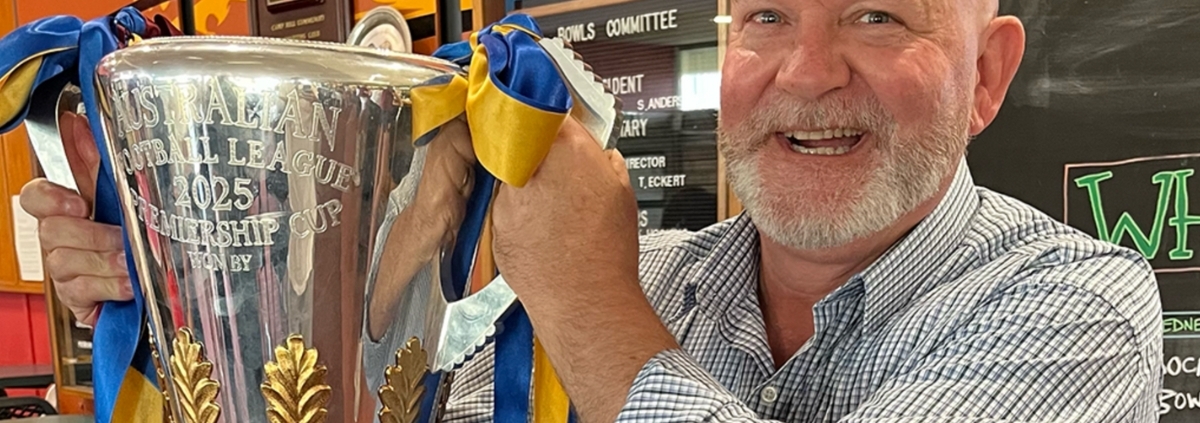Footy Chaplains Kicking Goals Behind the Scenes
By: Justin Rouillon
The last decade has seen chaplains at both elite and grassroots levels become commonplace, helping athletes and support staff tackle life’s other challenges.
It’s been a massive couple of weeks for Brisbane footy fans of all persuasions.
With the Brisbane Lions demolishing Geelong in the second half of the AFL Grand Final, and the Broncos taking out the NRL Premiership against the Melbourne Storm.
For many footballers, success at the highest level defines who they are. But what about away from the bright lights, the packed stadiums and hordes of adoring fans?
Who’s there for them when they struggle with not just the pressure of their jobs, but the normal things we all go through?
The numbers of sports chaplains, serving not just football clubs, but all sports at both elite and grassroots levels have increased dramatically over the past decade.
These days chaplains are common place, but it wasn’t always that way.
In a 2015 column for ‘The Australian’, Melbourne Storm coach and former Canberra Raiders player Craig Bellamy encouraged all clubs to consider appointing a chaplain.
He spoke of Father John Woods who has served the Raiders since Bellamy’s playing days in the eighties, and of the Melbourne Storm chaplain Grant Stewart – describing them as ‘two of the finest men I have ever met’.
Such is the respect that John Woods, now a Monsignor, holds with the Canberra Raiders for his almost 40 years of voluntary service, that they bestowed him with life membership of the club in 2022. Monsignor Woods was only the tenth life member of the Raiders at the time.
Even ten years ago Bellamy saw the benefits that chaplains brought to a footy club, especially in the areas of mental health.
“I believe chaplains are a much needed resource in our game,” Bellamy wrote in that column. “I think a lot of clubs don’t even realise the value they bring.”
Clearly, much has changed over the past decade. Someone who has seen the role of the sports chaplain elevated over that time is Paul Reis, who has been chaplain to the Brisbane Lions for sixteen years.
Originally a state level representative player and coach in Squash, Paul got his start in the space with a two-year stint at the Gold Coast Suns, as they gained entry into the AFL.
Paul gushes with pride as he speaks of the Lions taking out a second straight AFL premiership flag at the MCG.
Having been involved with AFL clubs for almost two decades, Paul has seen the growth of chaplaincy first hand.
“ There was some older, established chaplains that had been in their AFL clubs for some time, but a number of clubs still didn’t have chaplains.
“That’s now been remedied with chaplaincy represented across all AFL clubs, as well as at the AFLW level and VFL level. There’s now also many chaplains at community level so we’ve seen chaplaincy recognised at all levels of the sport.”
Paul’s role at the Lions sits in the wellbeing team, which compromises a wellbeing manager and an assistant, a psychologist and the indigenous officer.
At the heart of his role, Paul sees building relationships and investing time as key to supporting the Lions’ players and support staff.
“ I’ve always worked to two things in my chaplaincy; one is to be visible and the other is to be available,” Paul says.
Another sports chaplain who has seen footy chaplaincy go from strength to strength is Warren Crank, whose first involvement was with the Rugby League World Cup in 2008.
He subsequently spent five years as chaplain with the NRL’s North Queensland Cowboys, as well as serving in the Queensland Cup with the Townsville Blackhawks.
Warren is currently chaplain with Brisbane based North’s Devils, who also compete in the Queensland Cup.
“It’s a great hashtag – chaplain to the Devils,” laughs Warren, who agrees that an investment of time is paramount.
“What we learn as chaplains is that being around a lot is how relationships best form and how chaplaincy really thrives.
“With the Cowboys, I was there for a couple of years and then there was a very sad event, which I was called into immediately and asked to be around the club all the next day. And suddenly they thought this is why we have a chaplain here.”
Warren said that his role is to support players holistically and not just as professional athletes.
Like Paul, Warren has also seen the leadership of elite competitions become increasingly open to chaplaincy.
“In rugby league, especially with the Pasifika involvement, spirituality is increasingly understood as part of human flourishing and important in a club.
“I did the NRL wellbeing course a couple of years ago, and of the eight slices of the wellbeing pie, spirituality is one of them.
“Chaplaincy featured in a day long discussion about, for what many coaches and players can be that mysterious dimension of us called spirituality.”
“ I was on a recent NRL and Queensland Cup chaplain Zoom call, and one of the key wellbeing people from the NRL was on it too. Not necessarily a person of faith, but they said this is good – we want to encourage you in this.
“And they see that impact that you’re having on the teams, on the individuals. Everyone knows that what happens outside of footy affects what happens on the park.”
If you’re considering serving in a sports chaplaincy role, Warren’s book ‘Unofficial Chaplain’ is a great place to start.
There’s also plenty of information available at Sports Chaplaincy Australia’s website.
Paul says that it’s a great way to impact your community outside of the four walls of the church.
“When you consider the number of Aussies that play sport, to be able to walk into a sporting community and be that person of light, hope and support is invaluable.
“It’s a great opportunity to be able to be the right person at the right time, in those places.”
Article supplied with thanks to 96five.
Feature image: Supplied



